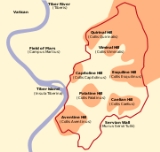
Seven hills of Rome
Overview
Tiber
The Tiber is the third-longest river in Italy, rising in the Apennine Mountains in Emilia-Romagna and flowing through Umbria and Lazio to the Tyrrhenian Sea. It drains a basin estimated at...
form the geographical heart of Rome
Rome
Rome is the capital of Italy and the country's largest and most populated city and comune, with over 2.7 million residents in . The city is located in the central-western portion of the Italian Peninsula, on the Tiber River within the Lazio region of Italy.Rome's history spans two and a half...
, within the walls
Servian Wall
The Servian Wall was a defensive barrier constructed around the city of Rome in the early 4th century BC. The wall was up to 10 metres in height in places, 3.6 metres wide at its base, 11 km long, and is believed to had 16 main gates, though many of these are mentioned only from...
of the ancient city.
The seven hills are:
- Aventine HillAventine HillThe Aventine Hill is one of the seven hills on which ancient Rome was built. It belongs to Ripa, the twelfth rione, or ward, of Rome.-Location and boundaries:The Aventine hill is the southernmost of Rome's seven hills...
(Latin, Aventinus; Italian, Aventino) - Caelian HillCaelian HillThe Caelian Hill is one of the famous Seven Hills of Rome. Under reign of Tullus Hostilius, the entire population of Alba Longa was forcibly resettled on the Caelian Hill...
(Caelius, Celio) - Capitoline HillCapitoline HillThe Capitoline Hill , between the Forum and the Campus Martius, is one of the seven hills of Rome. It was the citadel of the earliest Romans. By the 16th century, Capitolinus had become Capitolino in Italian, with the alternative Campidoglio stemming from Capitolium. The English word capitol...
(Capitolinus, Capitolino/Campidoglio) - Esquiline HillEsquiline HillThe Esquiline Hill is one of the celebrated Seven Hills of Rome. Its southern-most cusp is the Oppius .-Etymology:The origin of the name Esquilino is still under much debate. One view is that the Hill was named after the abundance of holm-oaks, exculi, that resided there...
(Esquilinus, Esquilino) - Palatine HillPalatine HillThe Palatine Hill is the centermost of the Seven Hills of Rome and is one of the most ancient parts of the city...
(Palatinus, Palatino) - Quirinal HillQuirinal HillThe Quirinal Hill is one of the Seven Hills of Rome, at the north-east of the city center. It is the location of the official residence of the Italian Head of State, who resides in the Quirinal Palace; by metonymy "the Quirinal" has come to stand for the Italian President.- History :It was...
(Quirinalis, Quirinale) - Viminal HillViminal HillThe Viminal Hill is the smallest of the famous seven hills of Rome. A finger-shape cusp pointing toward central Rome between the Quirinal Hill to the northwest and the Esquiline Hill to the southeast, it is home to the Teatro dell'Opera and the Termini Railway Station.At the top of Viminal Hill...
(Viminalis, Viminale)
The original city was held by tradition
Tradition
A tradition is a ritual, belief or object passed down within a society, still maintained in the present, with origins in the past. Common examples include holidays or impractical but socially meaningful clothes , but the idea has also been applied to social norms such as greetings...
to have been founded by Romulus
Romulus and Remus
Romulus and Remus are Rome's twin founders in its traditional foundation myth, although the former is sometimes said to be the sole founder...
on the Palatine Hill.
The seven hills of early Rome – the Cermalus, Palatium, and Velia
Velian Hill
The Velia — or Velian Hill or Velian Ridge — is a saddle or spur stretching out from the middle of the north side of the Palatine Hill towards the Oppian Hill ....
(the three peaks of the Palatine Hill), the Cispius
Cispius
Cispius is the nomen of the Roman gens Cispia.-Cispius Laevus:The Mons Cispius, or Cispian Hill, is one of several summits of the Esquiline Hill in Rome. The grammarian Festus says that it was named for a Cispius Laevus of Anagnia, of the Publilia voting tribe . This Cispius may be legendary.-M...
, Fagutalis, and Oppius (the three peaks of the Esquiline Hill), and the Sucusa – figured prominently in Roman mythology
Roman mythology
Roman mythology is the body of traditional stories pertaining to ancient Rome's legendary origins and religious system, as represented in the literature and visual arts of the Romans...
, religion, and politics.

